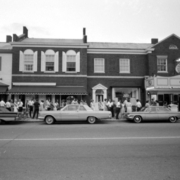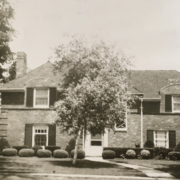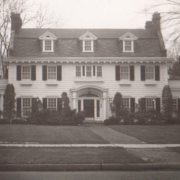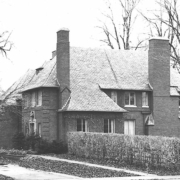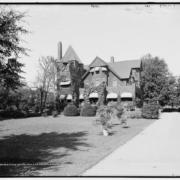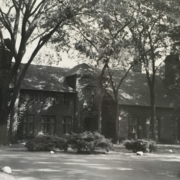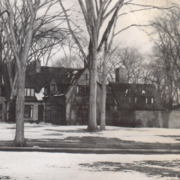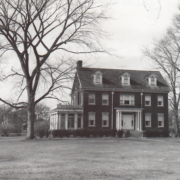Historical Architecture of Grosse Pointe – The Hill Commercial District
Last week we brought you the story of 8 Carmel Lane, designed by Albert Kahn in 1912, for prominent businessman Philip H. McMillan. The property was once set on 14 acres.
This week we move away from residential properties to bring you the story of one of Grosse Pointes most popular and iconic commercial districts – welcome to the story of the Hill. Image courtesy of: Walter P. Reuther Library, Archives of Labor and Urban Affairs, Wayne State University (1976)

The Hill, in Grosse Pointe Farms, is located on Kercheval Avenue running from Muir Road to Fisher Road. The small crest of land includes offices, shops, restaurants, and the main branch of the Grosse Pointe Public Library. For over 90 years, this prestigious three-block commercial center has been home to many elite stores and businesses. Images courtesy of: Katie Doelle
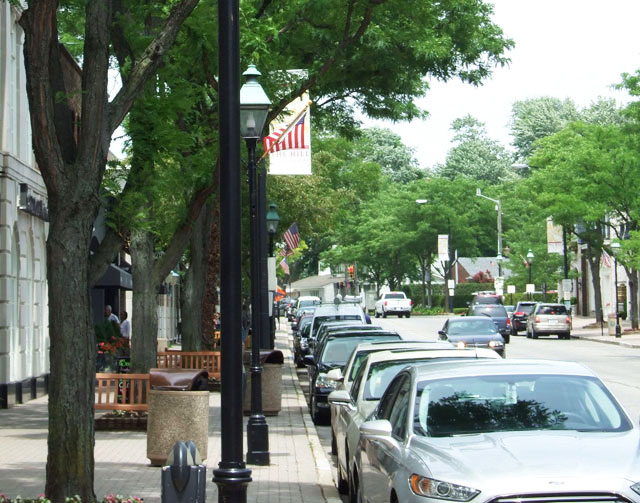

The area was originally part of a strip farm that once belonged to Joseph Ellair in 1808. In 1873, well-known businessman John S. Newberry purchased the property for $27,000 (around $614,000 today) to build his summer estate, “Lake Terrace”. It is reported, 20 years later, Newberry, along with the neighboring families of James McMillan and Joseph Berry, leased the southwest edge of the estate (running from Lake St. Clair to Ridge Road) to the newly formed Country Club of Detroit. Up until 1912, the area, between Fisher and McKinley, (the current location of Grosse Pointe South, the Grosse Pointe Central Library, and the Punch and Judy office building) was the location of the back fairways of the old Country Club golf course. Source: “Avenue of the Elite”, by Madeline McLaughlin – Heritage magazine, 1985.
By the mid 1920’s the area had undergone a dramatic transformation – the golf course had been sold, the land had been subdivided, new streets had been formed, and Grosse Pointe South High School was complete, opening in 1928. By the early 1940’s, the remainder of the former Newberry estate had been parceled off with a portion dedicated for commercial use – this is where the upper part of the Hill is located today.
The Hill, as a commercial center, began to take shape in January 1930, when the community’s first movie theater, the Punch and Judy, opened to much fanfare at 17 Kercheval Avenue. The opening not only marked the beginning of the theater, but of the business area in general, gradually heading north towards Muir Road as more and more business moved in. By 1935, several businesses had moved into the storefronts next to the Punch and Judy building (the block where Raymond James and Brooks Brothers is located today). The store front on the corner of Kercheval and Fisher (now the office of Wakefield, Sutherland & Lubera) became home to Thompson Books (later known as Connell Books), while one of the area’s finest florists was established by Arthur L. Paselk. Next to the florist was Felix Francois’ Beauty Shop. Also, in the block was a popular soda fountain, called the Punch & Judy Sodette – owned and operated by Mr. and Mrs. Eggerking (Mrs. Paselk’s parents). Image courtesy of: Walter P. Reuther Library, Archives of Labor and Urban Affairs, Wayne State University (1966).

By the late 1930’s the Connell Book store (previously named Thompson Books) had become the Pointe’s premier gift and home accessory store called Sign of the Mermaid. Meanwhile, at the far end of the Hill, the “uptown” area, on the corner opposite Muir Road, Joseph Vansinamae had opened a beer garden in a small building on the space that is now the location of the Bronze Door. The late 1930’s also witnessed the completion of a new building, in the first block (on the side of Muir Road), for interior designer William Denler. A few months later Paselk’s Florists, along with the Punch & Judy Sodette, relocated from the bottom of the Hill to the “uptown” area to their new Tudor style building.
During the 1940’s the “uptown” area continued to expand and attract more businesses, including a sporting goods store (located where the Christian Science Reading Room used to be) that was owned by Roland Gray (a tennis pro at the Country Club of Detroit). Meanwhile, the lower part of the Hill was also witnessing some significant changes – the stores fronts and offices next to the Punch and Judy theater were welcoming the arrival of some new tenants to take on the available spaces. Abbe Publishing moved in (original publishers of the Grosse Pointe News), as did the Junior League of Detroit who took an office upstairs in the building. Downstairs, in one of the available spaces, the Red Cross opened a “Bundles for Britain” store as part of an international effort (founded by Winston Churchill’s wife) to help those left homeless by the blitz in Great Britain. It is reported the branch was the only one of its kind in Michigan. According to an article in the Grosse Pointe News, November 7, 1940, ‘in the few months it has been in existence, “Bundles for Britain” has already shipped to England 8,000 scarves, 19,000 socks, 17,000 sweaters, 2,000 pounds of knitting wool, 345 crates of clothing, ten ambulances, thirteen rolling canteens, and eighty-nine crates of surgical supplies’.
Also, in the block (that housed the Punch and Judy building), during the 1940’s, Titus Drugs moved into the corner where Sign of the Mermaid had been previously located (Sign of the Mermaid had moved “uptown” to the first block of the Hill). In addition, the block welcomed Clyde Hornung’s children’s store. During this era, it is also reported the only service-oriented operations on the Hill were doctors and dentists. However, during the war several real estate agents opened offices on the Hill including Holden and Reaume, Inc, and the Maxon Brothers who established their office at 83 Kercheval where Higbie Maxon Agney remains located today. The Hill’s first real restaurant also arrived – Hawthorne House – an intimate colonial tearoom that proved very popular for ladies’ luncheons. Image courtesy of: Loopnet.com

The end of the war coincided with significant development of the Hill’s “uptown” area, with many structures being completed – including the building that was once home to the Grosse Pointe News (finished in 1945). Such was the expansion of the Hill; it is reported locals jokingly referred to the area as Rockefeller Center. Image courtesy of: Loopnet.com

During the 1950’s the Hill had become home to a couple of unique gift stores, including the Junior League of Detroit’s store that was run by the organization. Located at 70-72 Kercheval, this building was designed by noted architect John L. Pottle in 1946. The store was ultimately sold and became known as “The League Shop”. Meanwhile, the area by Fisher Road was undergoing extensive construction with the construction of the Grosse Pointe Central Library, opening in January 1953. The one-of-a-kind modern building was designed by internationally renowned New-York based architect Marcel Breuer. It was one of the final construction projects to be completed on the Hill for many years. Image courtesy of: C&GNews.com

The 1980’s witnessed several significant developments on the Hill. In 1984, the Punch and Judy Theater closed for good – the building was renovated into offices in 1986. One year later, in 1987, Brooks Brothers opened the store, in the same block, (where it remains today) in what had once been the location of the Hawthorne House restaurant. Image courtesy of: Crainsdetroit.com

Over the years the Hill has undergone many changes, has welcomed a wide range of businesses, and continues to evolve. The commercial district has been home to several drug stores, gas stations, grocery stores, real estate brokers, a Lincoln-Mercury dealership, a toy store, bookstores, and numerous restaurants. Many of the early established retailers have either retired, relocated, or gone out of business. Today the face of the Hill continues to develop, but one thing remains true – “as much as things change, they really stay the same”, Hugo Higbie.
Much of the research for the blog post is courtesy of “Avenue of the Elite”, by Madeline McLaughlin – Heritage magazine, 1985.
*Photos courtesy of the Higbie Maxon Agney archives unless stated.
Written by Katie Doelle
Copyright © 2021 Katie Doelle

